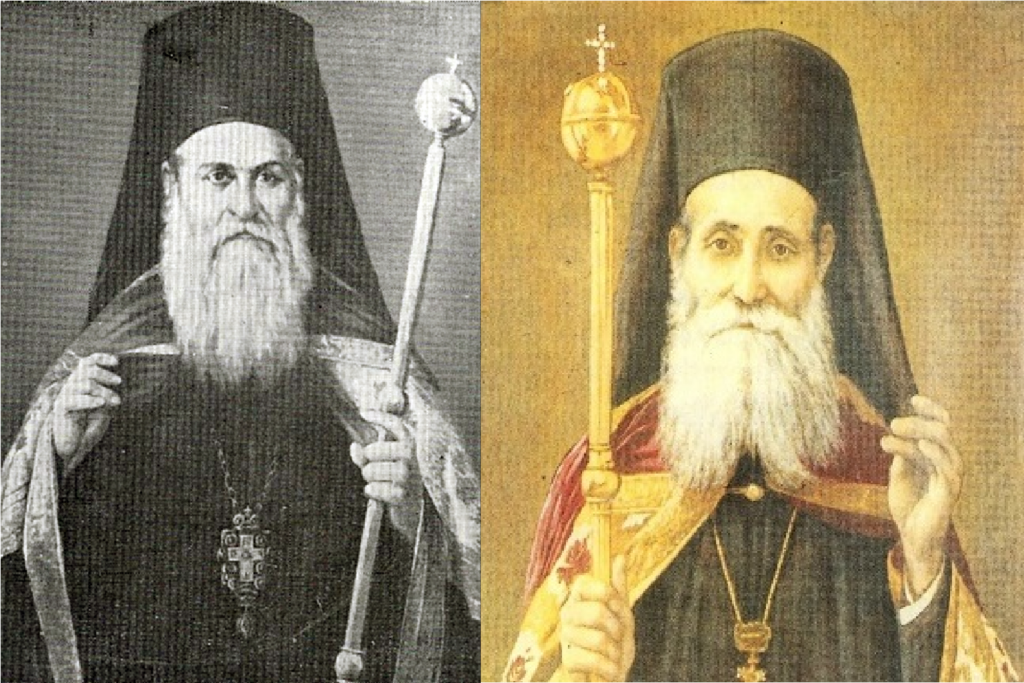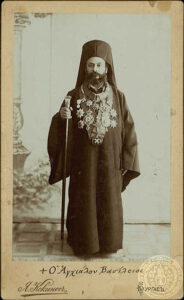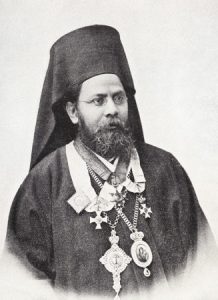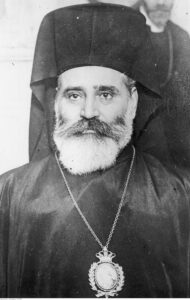On May 22, 1900, Archbishop Sophronios II of Cyprus died. This left just two bishops in the entire Church of Cyprus – the Metropolitan of Kition and the Metropolitan of Kyrenia. Both of these men were named Kyrillos. They would spend the next nine years vying for the Archiepiscopal throne. As one contemporary writer, Adrian Fortescue, summed up the two candidates, “My Lord of Kition is a politician and strongly Philhellenic in his sympathies. His enemies say that he is a Freemason. My Lord of Kyrenia is a very pious Churchman and godly bishop. His enemies say that he is a poor, weak creature, quite unfit to guide the Cypriote Church. All the Philhellenes are for him of Kition; the English Government would prefer the Kyrenian.”
Under normal circumstances, the Metropolitan of Paphos would have been responsible for organizing the election of a new Archbishop, but as it happened, that bishop had died in 1899, and the See of Paphos was still vacant, leaving a leadership vacuum. Then as now, the clergy and laity of the Church of Cyprus play a role in the selection of a new Archbishop. In August, a new election was held, and Kyrillos of Kition received an overwhelming majority of the votes, winning 46 to 14. But that didn’t settle the matter. The supporters of Kition had allegedly resorted to intimidation and violence to influence the electors, such that the Holy Synod of Cyprus, which included not only the two bishops but also three other leading clergymen, refused to recognize the election as legal.
In October, the partisans of Kition appealed to the Hellenic Patriarchates of Constantinople, Alexandria, and Jerusalem, as well as to the Church of Greece. The Holy Synod objected, and the British government that controlled Cyprus initially rejected outside intervention. After nearly a year of inactivity, in September 1901, the British agreed to let the new Ecumenical Patriarch, Joachim III (known as “Joachim the Magnificent”) send an envoy to the island. Joachim sent Demetrios Georgiades, ostensibly to try to make peace between the two competing Kyrilloses. It turned out, however, that the real aim of Georgiades was to convince the Cypriots to submit the whole dispute to the judgment of the Ecumenical Patriarch, who would unilaterally decide the matter. Privately, Georgiades told each side that the Phanar preferred their candidate. Kition was the first to reject Constantinopolitan intervention, which prompted Georgiades to claim that he had learned of grave allegations against Kition. He then offered to hear any allegations that Kition might like to make against Kyrenia. As a contemporary account explains it, “In reply, the Bishop [of Kition] merely expressed his regret that the other had not confined his efforts to the object of his mission and worked for peace.” In his final report at the end of October, Georgiades wrote that neither of the Kyrilloses was worthy of becoming Archbishop. The Patriarchal envoy ended his visit having failed to make any real progress in resolving the succession crisis.
Another year went by with no progress. In September 1902, the British colonial government tried a new approach, declaring that the Archbishop of Cyprus must be chosen by the Cypriot people according to their traditions. Meanwhile, the Greek Patriarchates decided to send envoys to investigate Kyrillos of Kition for charges of heresy. Kition wrote to the British authorities, explaining that the Patriarchates had no authority to intervene in the internal affairs of another autocephalous church. The same month, he hoisted the Greek flag at Trooditissa Monastery, proclaiming Cyprus to be united with the Greek state — an idea called “enosis” that would dominate Cypriot politics throughout the 20th century.
Despite all this activity in 1902, the year ended with no actual progress in Cyprus: the two Kyrilloses remained in contention and neither the British government nor the Greek Patriarchates could break the stalemate. This state of affairs persisted for the next five years.
***
Finally, in April 1907, both Kyrilloses appealed to the Patriarchs of Constantinople, Alexandria, and Jerusalem to send representatives to Cyprus. The Patriarchs responded immediately: Patriarch Photios of Alexandria would head the delegation himself, and he would be joined by Metropolitan Basil of Anchialos (Ecumenical Patriarchate) and 35-year-old Archimandrite Meletios Metaxakis (Jerusalem).
The delegation arrived in Cyprus three months later. Photios of Alexandria favored Kition, while Basil of Anchialos sided with Kyrenia. Meletios Metaxakis, the Jerusalem representative, took a neutral stance. As winter approached, the delegation seemed to have little to show for its efforts and suspended its work. Photios of Alexandria and Meletios Metaxakis returned home, but Basil of Anchialos remained in Cyprus and openly campaigned for his favored candidate, Kyrillos of Kyrenia.
In the early months of 1908, with Basil of Anchialos in Cyprus pushing hard for Kyrenia, telegrams flew back and forth among the Greek Patriarchates. On February 10, the Holy Synod of Constantinople unilaterally elected Kyrenia as Archbishop of Cyprus – a direct violation of Cyprus’s autocephaly. When the church bells in Nicosia rang to announce the new Archbishop, the Kition faction stormed the archiepiscopal palace, leading the British authorities to declare martial law. Kyrillos of Kyrenia repeatedly attempted to resign, but under pressure from his supporters and the Phanar, he retained his claim to the throne.
In a blow to the prestige of the Ecumenical Patriarchate, both Alexandria and Jerusalem refused to recognize the election, and now the Phanar was faced with the awkward task of extricating itself from the situation without losing face. In May, the Cypriot government passed the “Archiepiscopal Election Law of 1908,” which provided for an ad hoc electoral synod that would include bishops from other autocephalous churches. Kyrillos of Kition immediately asked Patriarch Photios of Alexandria to bring three bishops to Cyprus to constitute the electoral synod and put Kition on the throne. Photios, who only had one other bishop in his entire Patriarchate, hastily consecrated two more, and in November, he and his bishops came to Cyprus to act as members of the electoral synod.
Before becoming Patriarch of Alexandria, Photios had been a rising star in the Patriarchate of Jerusalem. As the Cypriot drama played itself out, Photios connected with the young Jerusalem envoy, Meletios Metaxakis, and they formed an alliance against their mutual rival, Patriarch Damianos of Jerusalem. When Damianos learned of this, he halted Meletios’s advance up the ladder in the Jerusalem Patriarchate. In November, Meletios secretly traveled to Alexandria to meet with Photios, The pair planned a coup d’etat against Damianos. (Click here to read the full story of that coup attempt.) The coup failed, and in early 1909, Meletios and fellow conspirator Chrysostomos Papadopoulos (future Archbishop of Athens) had to flee Jerusalem under Turkish guard. They ended up in Constantinople, where they lobbied against Damianos. This failed, and Meletios, now exiled from Jerusalem, took up residence in Constantinople.
***
At this point in the Cypriot succession crisis, which was approaching its ninth anniversary, the two candidates – Kyrillos of Kyrenia and Kyrillos of Kition – were each backed by an ancient Patriarchate – Constantinople and Alexandria, respectively. The Ecumenical Patriarchate viewed Kyrenia as the rightful Archbishop, having been elected by the Holy Synod of Constantinople. The Alexandrian Patriarchate saw Kyrenia’s election by Constantinople as being totally uncanonical, a violation of Cyprus’s autocephaly – but Alexandria was also perfectly happy to lend its bishops to Cyprus for an election, where Kition was sure to prevail.
In early 1909, as the Jerusalem coup drama continued to unfold, Photios of Alexandria visited Constantinople and conferred with Ecumenical Patriarch Joachim, who finally expressed a willingness to accept Kyrenia’s resignation as Archbishop. To save face for the Phanar, Joachim insisted that Kyrenia be granted the title “former Archbishop of Cyprus.” In April, the Church of Cyprus finally held a new election, which was boycotted by the supporters of Kyrenia, who claimed that their man was the Archbishop and thus that no election was necessary or legal. Thus Kyrillos of Kition ran unopposed and was elected Archbishop Kyrillos II. (Of course, Kyrillos of Kyrenia also claimed to be Kyrillos II!)
Initially, the Ecumenical Patriarchate refused to recognize Kition’s election, continuing to treat Kyrenia as the rightful Archbishop. The newly-elected Kyrillos II (i.e., Kition) then took steps to fill the long-vacant see of Paphos, as well as his own former see of Kition. And, in a direct threat to his rival, he declared the see of Kyrenia to be vacant and appointed a locum tenens. The writing was on the wall, and in November, Ecumenical Patriarch Joachim wrote to Patriarch Photios of Alexandria, asking Photios to intervene to end the conflict in Cyprus. Joachim saw that the battle was lost, and he was done supporting Kyrenia’s claim. Kyrillos of Kition had won.
***
In February 1910, the Church of Cyprus prepared to fill the vacant sees of Paphos and Kition. Cyprus formally requested that the Patriarchate of Alexandria send bishops to help with the upcoming consecrations. As soon as the Alexandrian bishops arrived, they met with Kyrillos of Kyrenia – the erstwhile claimant to the Cypriot throne – and convinced him to abandon his claim and accept his status as Metropolitan of Kyrenia. As part of the deal, Kyrillos of Kyrenia was given the title, “Most Blessed President of Kyrenia,” and Archbishop Kyrillos II (formerly of Kition) agreed that the vacant sees of Paphos and Kition would not be filled by partisans of either of the Kyrilloses.
After close to a decade of fighting, the two bishops made peace. Both men addressed the faithful with words of reconciliation. Archbishop Kyrillos II acknowledged the unpleasantness of “these lamentable ten years” and called for “love, peace, and reconciliation.” Kyrillos of Kyrenia promised to assist the new Archbishop and “wipe out that barren period of ten years and render the Church more glorious in appearance.” He concluded, “Long live His Beatitude the Archbishop of Cyprus.”
Meletios Metaxakis, exiled from Jerusalem and licking his wounds in Constantinople, was elected Metropolitan of Kition. Just before leaving Constantinople, Meletios was initiated as a Freemason at the Harmony Lodge. Arriving in Cyprus, Meletios resumed his ascent to greater power in the Orthodox Church — an ascent that would, in time, see him take the thrones of Athens, then Constantinople, and finally Alexandria. (Incidentally, Basil of Anchialos, the Ecumenical Patriarchate’s envoy to Cyprus in 1907-08, also went on to become Ecumenical Patriarch, from 1925 to 1929.)
As for Archbishop Kyrillos II (formerly of Kition), he remained on the throne of Cyprus until his death in 1916, and he was succeeded by his former rival, Kyrillos of Kyrenia, who became Kyrillos III, reigning until his own death in 1933.
Main Sources
Adrian Fortescue, The Orthodox Eastern Church, 2nd ed. (London: Catholic Truth Society, 1908).
John Hackett, “The Archiepiscopal Question in Cyprus,” The Irish Church Quarterly 1:4 (October 1908), 320-339.
John Hackett, “The Close of the Archiepiscopal Question in Cyprus,” The Irish Church Quarterly 3:11 (July 1910), 230-242.
Andrekos Varnava and Michaelis N. Michael, eds., The Archbishops of Cyprus in the Modern Age: The Changing Role of the Archbishop-Ethnarch, their Identities and Politics (Cambridge Scholars Publishing, 2013).
“Pour le siège archiépiscopal de Chypre,” Echos d’Orient 5:6 (1902), 397-403.



